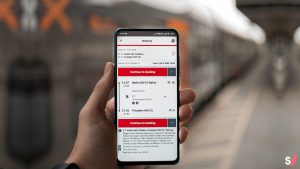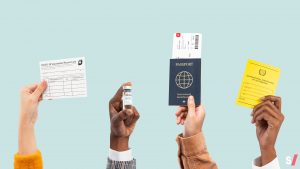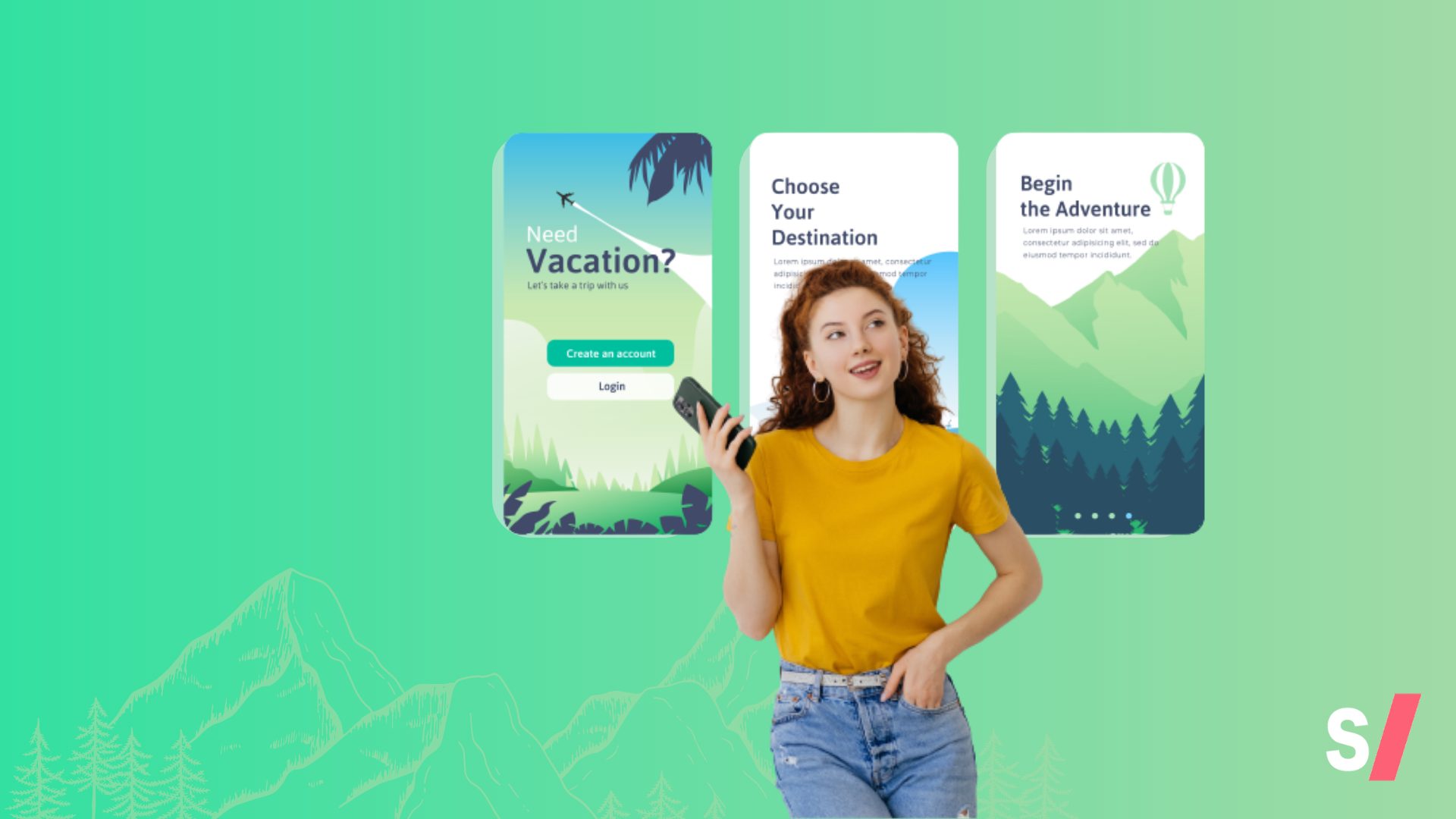After COVID-19 restrictions went down, you are more likely to book your dream getaway. Meanwhile, the pandemic hasn’t passed without a trace, having changed the way we travel. During the last two years, adventure seekers became more equipped in terms of mobile apps.
New tools have taken hold in the travel industry. Some of them ensure contactless services during a trip, the others streamline travelers’ decision making process.
Mobile developers have considered other global issues, like military conflicts and air pollution, to help people be more informed, mapping their next transportation. So, let’s dive into the list of hot technologies influenced by recent trends.
1. Immersive travel experience

Deprived of excitement on travels, Americans spent months in enclosed spaces during the last two years. That fact prompted technical companies to develop new solutions to satisfy people’s needs. One of them is an immersive audio guide.
The world’s largest travel platform Tripadvisor teamed up with Amazon’s voice assistant Alexa to bring the thrill of wanderlust to any place where you are. You just need your phone.
Through Alexa, users get into a virtual voice tour based on their preferences. Having a dialogue with Alexa, a person gets personalized suggestions based on numerous TripAdvisor reviews. But how does it work?
Travelers gain immersive audio experience due to machine learning. In particular, the technology enables the collection of data and adds content to the conversation tree between Alexa and a user. In addition, Alexa memorizes the path of a customer, and when it finishes, the tool suggests related options. So, where do you want to travel?
Currently, Alexa could guide you along two destinations: Abu Dhabi, the capital of UAE; and Orlando, the city in the South of the US.
2. Asylum for refugees

Hearing a war alert or bombing on the neighboring street is probably the last thing a peaceful person wants to experience. If you are aware of the inhumane conditions during the war in Afghanistan or the bloodshed in Ukraine, you can feel for the millions of people fleeing from the hotspots. To help refugees find shelter abroad, international NGOs and tech enterprises get together and design supportive apps.
One of the first mobile apps of this kind, Signpost, was launched in 2015 by the IRC and Mercy Corps at the height of the European refugee crisis in Greece. Tech enterprises like Cisco, Google, Microsoft, and TripAdvisor supported the initiative by providing in-kind expertise in technology.
In practice, the Signpost app delivered to displaced people critical information about legal services, and housing support in the foreign state. Today, Signpost has expanded to 15 countries, but armed conflicts appear unpredictably across the globe. That is the reason why individual countries and tech enthusiasts autonomously develop new applications as soon as possible.
In 2022 dozens of platforms were crafted in 1-2 months to help Ukrainian society. Irish and Czech governments built applications such as Swift Integration and Smart Migration to help refugees resettle in these states. That implies accommodation assistance, health, education, and employment services.
Besides these attributes, one of the apps, Smart Migration, features an intelligent personal assistant using natural language processing technology. That enables people to get audio answers to their urgent questions in their native language.
3. Eco-friendly vacations

People, originally, get used to traveling without a second thought about their carbon footprint. What is your vision on the issue? You might find yourself apart of the global green movement even if you resonate with it.
If you want to contribute more to global sustainability by taking simple steps, here mobile apps come to your assistance. There are plenty of accessible tools that bridge the gap between ordinary travelers and unknown environmental facts.
Have you heard that plane journeys leave the biggest carbon footprint? The application TripIt can assist you in tracking it during your flight. The app is based on the “Greenhouse Gas Protocol” allowing you to see in detail how carbon emissions have been measured. At the same time, the app gives you recommendations on how to offset the negative effects.
It’s also worth taking a look at Helsinki City App. The solution is deemed to be a good illustration of how to help visitors pick low-impact activities, hotels, and transport. The municipality created such a tool to become a completely carbon-neutral city by 2035.
Another European megapolis, Barcelona, launched a like-minded app. The solution also venables visitors to reduce their carbon footprint while getting the most out of the city.
4. Door-to-door experience

Do you feel stressed while planning multicity itineraries with public transport? Most people do.
Exploring numerous offerings across several online booking systems drives travelers nuts, as they need to carefully match all the connections between stations and accurately book the tickets every time. Several tech giants showed an intent to solve this issue.
During the last year, Uber and Cytric stated the plans to move away from single-purpose apps toward multi-purpose transportation solutions, allowing smooth trip booking. The latest survey, carried out by Google, supports this strategy.
Google conducted research in APAC where the amount of mobile app downloads is the highest in the world. The survey has revealed that 67% of local travelers prefer using an app with various functions rather than many single-purpose apps. In practice, the trend concerns not only the Eastern world.
The global rideshare company Uber plans to add extra features to its U.K. app, to make a traveler experience more complete. By the end of 2022, the app users will have been able to book trains, buses, planes, and rent cars.
Although the company won’t create these services itself, they will be provided by the partnering platforms that sell tickets. While the private journey is becoming even more smooth, business travel is also a matter of rethinking.
In 2022, the end-to-end corporate travel application Cytric has merged with the ground transportation platform Karhoo. Before the integration, Cytric assisted corporate users just in tracking general travel details and expenses. To empower visitors with more possibilities during their trips, the company has initiated integration with Karhoo. Now, with the tool, users can book and pre-book rides in more than 1,000 cities across the globe.
5. Virtual lines

Depressing statistics of COVID-19 have demonstrated that the taken hygiene precautions go down the drain when you get to a crowded place. In the worst nightmare, you could dream to stay in a long line at the airport.
Luckily, there were introduced virtual queuing technologies that allow maintaining proper social distancing while visitors wait in line. Airports and amusement parks are the first sites where the technology has been introduced. Despite the infrastructural differences between these locations, the algorithm behind a queueing solution remains mainly the same.
At a check-in point, visitors scan a QR code using a queueing application, then they make a reservation. Customers can follow a countdown to see how much time is remaining until it’s “their turn” to join the line.
Several major airports across the US, namely Seattle’s SeaTac Airport, New York JFK, and Boston Logan, have implemented the solution. The biggest theme park, Walt Disney World, was the next place that injected virtual lines in 2022.
6. Budget-first travels

Imagine yourself 10 years ago booking a trip to Japan at a travel agency. An advisor sitting in front of you puts together great itineraries tailored to your budgets, interests, and time constraints.
Today, you don’t have to go to a travel bureau for it. You can do it by yourself, using an appropriate mobile app.
For instance, the travel discovery app Elude facilitates the search for adequate accommodation and transportation that meet a traveler’s budget. Literally, the solution shows people how far their money can take them.
The founders have come up with the idea of the Elude app inspired by the following issue: travelers spend countless hours scrolling in search before they actually start a trip. Therefore, Elude becomes truly helpful for thousands of users, lowering the time they spend on the search. The tool shows both flight and hotel offers, designing a holistic travel package for a user.
Another application, Glooby, put in a heat of its strategy a similar approach: the cheaper it becomes to book a vacation, the more would-be travelers will do it. To deliver such a service, the app cross-references flights and hotels across multiple booking platforms.
Moreover, travelers can track their potential environmental impact within the app. That allows users to go wallet and eco-friendly at the same time.
7. Vaccine passport

One of the things you do to fulfill your globetrotting plans is checking whether your COVID-19 vaccination status is up-to-date. Additionally, to head to the new destination, you review the country-specific entry requirements. All that compile an abundant list of details to look over.
To facilitate the process, governments and private companies have developed apps that insert the vaccination certificates of citizens. You can also learn foreign entry requirements within these apps.
In the US, travelers employ the application Clear to store digital versions of their vaccine cards for easy access when traveling. The solution is mainly used in major airports, in cities like Los Angeles or New York City. At the same time, Clear can be used for visiting public events like sports matches.
Another great solution, created by the World Economic Forum, is the CommonPass app. Users can connect their test results and vaccination records to the app, which will compare them against individual countries’ COVID-related entry requirements.
Conclusion
The travel sector is hopefully bouncing back after COVID-19. That has led to the creation of new more engaging digital tools and an upgrade of established ones.
New players in the industry scan the gaps in the market to fill them, while the behavior of travel application users constantly evolves. Established companies draw travelers’ attention by making their journey even more complete using just one app.
In 2022, the world was also challenged by a humanitarian crisis. In this perspective, replacements of people were caused by urgent need. Governments have played an especially important role in providing war refugees with transportation and housing assistance.
Additionally, the states have initiated mobile application development to provide people with comprehensive databases at their fingertips.
With all these trends and new apps, people have become even more overwhelmed with which solution to choose. To ensure you deliver the most influential tool, we suggest you regularly assess the market demand and industry trends.
22 September 2022





